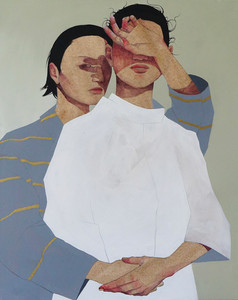Stillness on Canvas: Xenia Gray on Emotion, Presence, and Healing Through Contemporary Figurative Art
- Selfless Art Gallery

- Jul 4
- 4 min read
Updated: Sep 10
In today’s fast-paced world, art that invites stillness, reflection, and emotional connection feels more vital than ever. In this intimate artist interview, we explore the story behind contemporary figurative painter Xenia Gray, whose work bridges the quiet power of presence with raw emotional depth. Rooted in themes of vulnerability, mindfulness, and personal transformation, her paintings offer more than visual impact—they create space for healing and human connection. Through a conversation that touches on yoga, meditation, and her evolving color palette, we uncover how this emerging artist transforms lived experience into emotionally resonant works of art.
Q: Let’s start off with a fun ice breaker: If your art practice were a yoga pose, which one would it be—and why?
A: If my art practice were a yoga pose, it would be Savasana—Corpse Pose. It’s the most still yet most alive moment of practice. That’s where everything integrates, and you’re present with whatever arises. Similarly, when I paint, I try to quiet my inner noise and meet the canvas with openness. The art emerges not from force, but from presence.
Q: Can you walk us through your background and the journey that brought you to art?
A: I grew up in post-Soviet Siberia, in an environment where emotional expression wasn’t encouraged. I was also bullied in school, which led me to build a shell around myself. It became hard for me to express vulnerability in life—so I found a different outlet. Art became a space where I could be honest. I painted what I couldn’t say.
While I’ve spent many years working in the design industry, painting slowly took up more space in my life. It started as a personal necessity and grew into a dedicated practice. I still take on design projects, but art is where I feel the most connected to myself and to others.

Q: In our previous conversation, you mentioned that meditation and yoga played a big role in helping you through periods of depression. How did these practices begin to influence your creative journey?
A: Meditation taught me to stay with discomfort without needing to fix it or escape. That’s shifted the way I paint. Earlier, my work often emerged from emotional turbulence—driven by the need to be seen. Over time, as I learned to be present with myself, my art became more grounded. There’s now more stillness, more space, and more compassion—toward myself and others—in my work.
Q: Was there a moment or specific artwork where you first noticed presence and stillness surfacing in your paintings?
A: Yes—there was a painting I did a few years ago of two people touching hands without looking at each other. There was a quiet energy in that piece that I hadn’t seen before in my work. It wasn’t dramatic, just a simple, tender moment of connection. I remember feeling calmer while painting it, more aware of my breath. That was the beginning of something new.
Q: Looking at your work over the years, there’s a noticeable evolution in your color palette. Can you walk us through what prompted that shift—emotionally or artistically?
A: In the past, my palette was often raw—reds, blacks, intense contrast. It mirrored a certain emotional urgency. As I became more self-aware and moved through healing, I found myself reaching for more muted, earthy greens and calming blues. I think the palette softened as I softened. Now I choose colors based on the emotional resonance of the piece, not just intensity.
Q: There’s an intimacy and vulnerability in your subjects. What role does the body play in expressing what words can’t?
A: The body holds everything—our stories, our tension, our tenderness. I’m fascinated by how a gesture, a gaze, or the way someone holds their shoulders can say what words cannot. I often paint groups or pairs of figures, and I try to capture those small but potent moments of interaction. The body becomes a portal—an honest one—for expressing connection, longing, and presence.

Q: As we come to the end of our conversation, when a viewer encounters your work, what kind of internal dialogue or emotional response do you hope it stirs in them?
A: I hope they pause. I hope they feel seen, or recognize something quiet within themselves. My paintings aren’t about answers; they’re invitations—to feel, to reflect, to be still for a moment. If someone walks away from my work with a sense of softness or curiosity about their own emotional landscape, then I’ve done my job.

This interview offers a glimpse into an art practice shaped by inner stillness, personal healing, and deep emotional honesty. From her roots in post-Soviet Siberia to her present-day studio, Xenia Gray’s journey reminds us that the most powerful artwork often arises from presence—not performance. As collectors and curators continue seeking artwork that speaks to the human condition, her paintings stand as a testament to the transformative power of contemporary figurative art. To see more of Xenia Gray's incredible work and stay updated on her latest projects, be sure to follow her on Instagram and visit her website.


















Comments